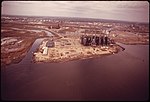Morses Creek (New Jersey)

Morses Creek is a stream in Union County, New Jersey. It is a tributary of the Arthur Kill along with other rivers and streams, including the Elizabeth River, Rahway River, Piles Creek and Fresh Kills, and via Newark Bay, the Passaic River and the Hackensack River. Earlier names include Thompson's or Nine Mile Creek as well as Morse's Creek or Morse Creek. It is named for the family of Peter Morse, also spelled "Morss," who settled here in the 1600s and remained for 200 years; Morse family headstones may still be seen to this day. On its route to the Arthur Kill, it traverses Kenilworth, Cranford, Roselle Park, Roselle, Union and Linden. In Cranford it runs behind Adams Park. It crosses near Roselle Park High School. In Linden and Roselle, it crosses the land of Wheeler Park and Roselle Catholic High School. It bisects the Bayway Refinery on the Chemical Coast. Historically, the land of the lower creek included prosperous tidewater farmland.
Excerpt from the Wikipedia article Morses Creek (New Jersey) (License: CC BY-SA 3.0, Authors, Images).Morses Creek (New Jersey)
Brunswick Avenue,
Geographical coordinates (GPS) Address Nearby Places Show on map
Geographical coordinates (GPS)
| Latitude | Longitude |
|---|---|
| N 40.637193 ° | E -74.214449 ° |
Address
Brunswick Avenue
07202
New Jersey, United States
Open on Google Maps





